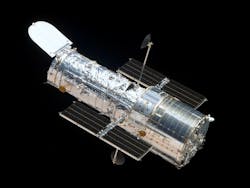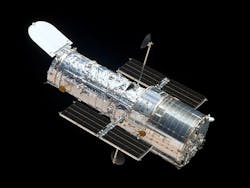The Hubble telescope has been orbiting Earth for 25 years collecting data on distant celestial objects, thanks to engineers at Perkins-Elmer who developed the optics and those at Lockheed Missile and Space Co. who designed the spacecraft itself.
Here some facts about the telescope you probably didn’t know:
- Since the telescope began operating in 1990, it has made over 1.2 million observations and traveled over 3 billion miles as it has orbited 340 miles above Earth at 17,900 mph.
- All those observations are captured in digital files that total over 100 Terabytes.
- Astronomers have used all those observations to generate over 12,800 scientific papers, making the Hubble one of the most productive scientific instruments ever designed and built.
- There are no rockets or thrusters onboard the Hubble. To change directions, it spins reaction wheels that, thanks to Newton’s Third Law of Motion, make the telescope spin in the opposite direction. The wheels spin at about the speed of a clock’s minute hand, turning 90 degrees in 15 minutes.
- Hubble operates on only 2,800 W, a little more than an electric range’s largest burner on high. The telescope gets all its electricity from a pair of solar panels that measure approximately 23 Ñ 9 ft (each).
- Engineers gave Hubble a pointing accuracy of 0.007 arc seconds, which is analogous to aiming a laser and hitting a dime 200 miles away.
- The most distant objects Hubble has seen are 13.4 billion light years
- The Hubble takes only black-and-white images. The spectacular color images you see from the Hubble are made by combining two or more black-and-white exposures through colored filters. Then, when the image is further processed, colors matching the filters are added.
Happy Anniversary, Hubble Telescope!
About the Author
Stephen Mraz Blog
Senior Editor
Steve serves as Senior Editor of Machine Design. He has 23 years of service and has a B.S. Biomedical Engineering from CWRU. Steve was a E-2C Hawkeye Naval Flight Officer in the U.S. Navy. He is currently responsible for areas such as aerospace, defense, and medical.
Sign up for our eNewsletters
Get the latest news and updates

